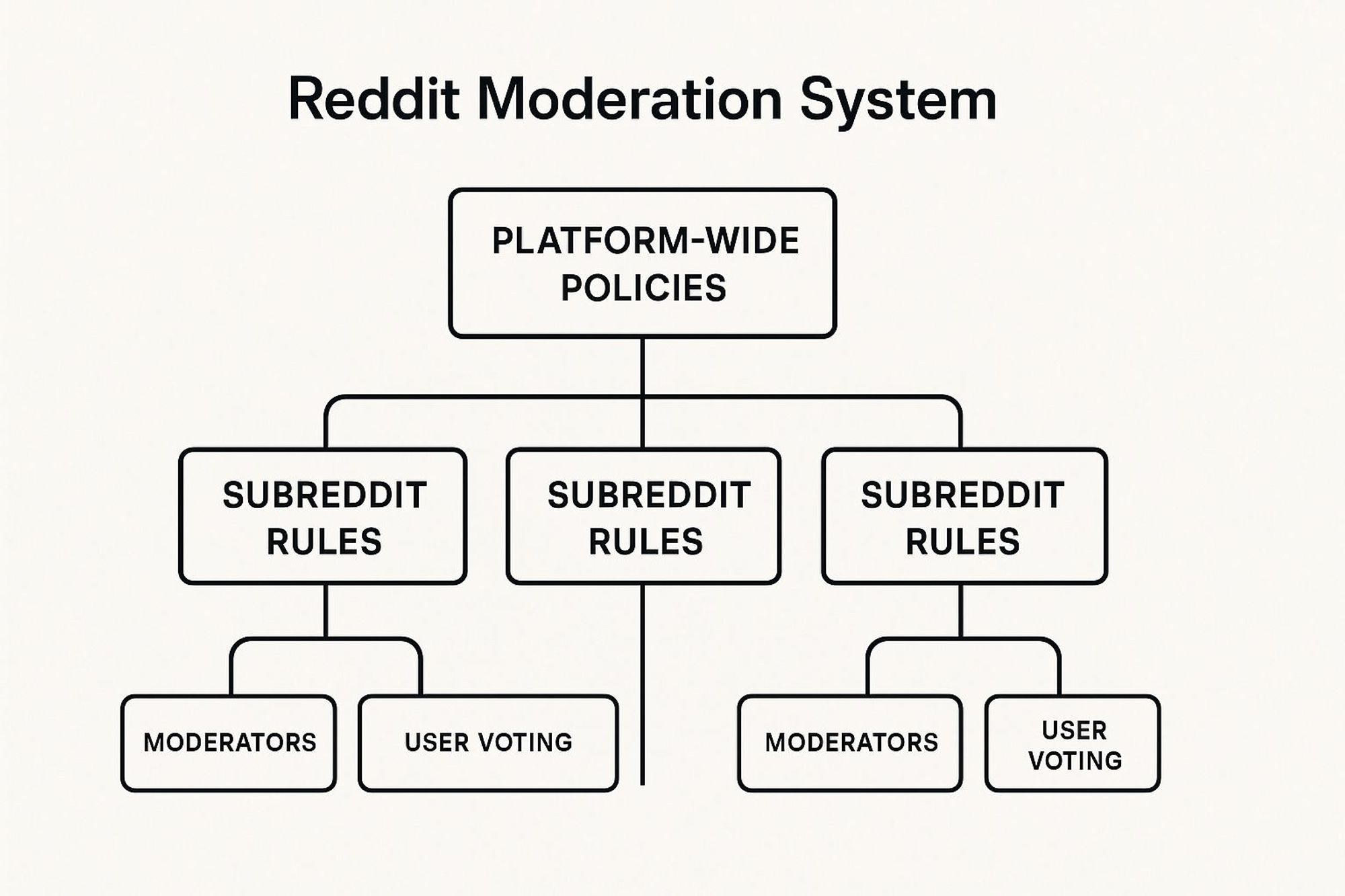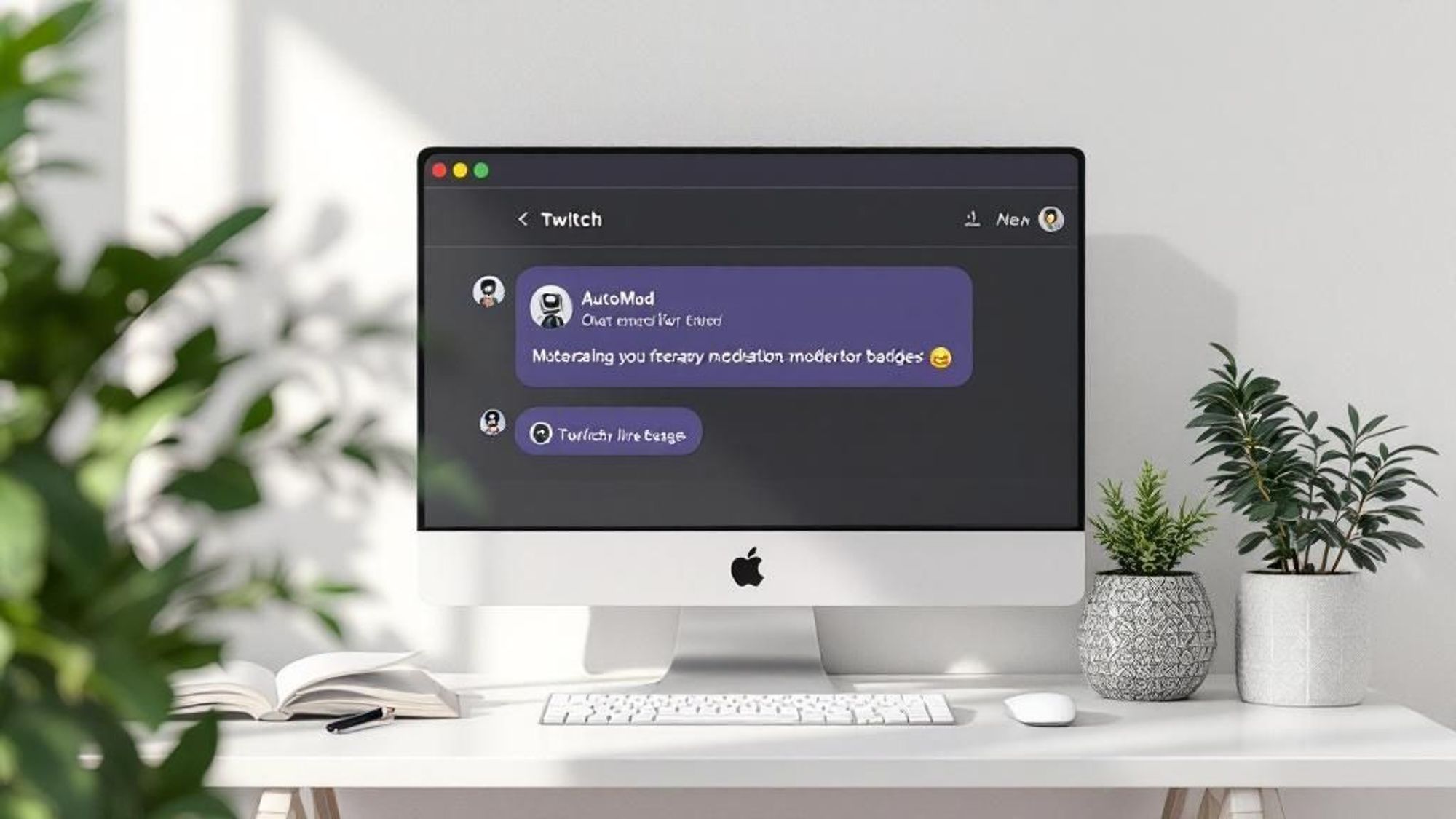Wednesday, July 23, 2025
7 Top Community Guidelines Examples for 2025

Building a vibrant online community goes beyond a simple "be nice" rule. Effective community guidelines are the constitution of your digital space. They set the tone, define boundaries, and empower members to interact safely and constructively. A well-crafted set of rules is the difference between a thriving hub of engagement and a chaotic, unmoderated free-for-all. As digital spaces on platforms from Discord to dedicated brand forums become central to business identity, getting this foundation right is non-negotiable for sustainable growth.
This article breaks down seven real-world community guidelines examples from some of the internet's most successful platforms, including Reddit, Twitch, and Stack Overflow. We'll move past surface-level descriptions to provide a deep strategic analysis of what makes each example effective. You'll get specific, replicable tactics and actionable takeaways to apply directly to your own community. Whether you're a brand manager overseeing a large Facebook Group or a solo creator building a niche following on GitHub, understanding these blueprints is the first step toward fostering a positive and self-sustaining online environment. Let's dive into the strategies that transform a simple set of rules into a powerful tool for community building.
1. Reddit Community Guidelines and Subreddit Rules
Reddit’s approach to moderation is one of the most effective and scalable community guidelines examples available. It employs a powerful two-tiered system that balances platform-wide safety with hyper-specific community needs. At the top level, Reddit enforces a universal Content Policy against harassment, illegal content, and other major violations.
Beneath this umbrella, each individual community, or "subreddit," creates and enforces its own set of rules. This layered structure empowers niche communities to cultivate unique cultures and maintain specific standards, a key reason for its inclusion in this list.
Analysis: A Decentralized Moderation Model
The genius of Reddit's model is its decentralization. Instead of a single, top-down authority dictating all interaction, power is distributed to volunteer moderators who are deeply invested in their communities.
- r/AskScience: This subreddit enforces strict rules requiring that all top-level comments be accurate, sourced, and in-depth answers from qualified individuals. This ensures the community remains a reliable resource for scientific information.
- r/personalfinance: Here, rules dictate specific post formats, including age, income, and goals, which standardizes questions and helps members provide relevant, actionable advice.
This system allows for incredible scalability. A rule that works for a gaming community would be irrelevant in a financial advice forum. Reddit's model accommodates both.
Strategic Takeaways for Community Builders
The following hierarchy diagram illustrates Reddit's layered moderation structure, showing the relationship between platform-wide policies, specific subreddit rules, and the enforcement mechanisms.

The visualization clarifies that while platform policies are the foundation, the day-to-day user experience is primarily shaped by community-specific rules enforced by moderators and user voting. For your own community, this layered approach provides a blueprint for creating both broad safety nets and tailored local guidelines.
Key Insight: Empowering trusted community members to act as moderators for specific channels or topics (like a "beginners" channel vs. an "advanced" one) can foster a stronger sense of ownership and more relevant enforcement.
This model is ideal for large, diverse platforms where a one-size-fits-all rulebook would fail. It allows different user groups to self-organize and maintain standards that are relevant to their specific interests, creating a more sustainable and engaging environment for everyone.
2. Discord Server Community Guidelines
Discord's approach builds upon the decentralized model by focusing on real-time engagement and granular permissions, making it one of the most dynamic community guidelines examples for live interaction. Like Reddit, Discord uses a two-tiered system: universal Community Guidelines for the entire platform and server-specific rules created by administrators. These rules govern interactions across distinct text and voice channels.
This structure allows server owners to create highly customized and organized spaces. The emphasis is on real-time moderation, with tools designed to manage live chat, voice conversations, and user access levels, which is crucial for fostering positive community engagement on social media platforms like Discord. This makes it a powerful framework for communities that thrive on instant communication.

Analysis: Channel-Specific Rules and Role-Based Permissions
Discord's strength lies in its channel-based organization and sophisticated role system. Instead of a single feed, communities are broken down into specific channels, each with its own purpose and rules. This segmentation is reinforced by a powerful role-based permission system that dictates who can see, post, and moderate specific areas.
- Gaming Communities: Servers for games like Valorant or Minecraft often have separate channels for general chat, looking-for-group posts, strategy discussions, and off-topic memes. Each channel has rules to keep conversations focused.
- Educational Servers: University or study group servers create channels for different subjects, announcements, and resource sharing. Roles can be assigned to "Verified Students" or "Tutors" to grant access to specific academic materials, ensuring integrity.
This channel-and-role combination allows community managers to create a clear, navigable structure where members know exactly where to go for certain types of interaction and what behavior is expected there.
Strategic Takeaways for Community Builders
The key takeaway from Discord is the power of combining automated tools with human oversight in a structured environment. Automoderation bots can handle spam, forbidden words, and link posting, freeing up human moderators to focus on nuanced interpersonal conflicts and community-building activities.
This visual shows how a new user flows through a well-structured Discord server, from accepting rules to gaining roles and accessing specific channels.
Key Insight: Create a dedicated#rulesor#welcomechannel that users must acknowledge before gaining full server access. This simple step ensures every new member is aware of the community standards from the moment they join, reducing unintentional rule-breaking.
This model is perfect for communities that require both free-flowing conversation and organized, topic-specific discussions. By creating clear channels and leveraging bots for baseline moderation, you can build a scalable and engaging real-time community without overwhelming your human moderation team.
3. Facebook Groups Community Standards
Facebook’s model for group governance provides another powerful instance of layered community guidelines examples. It functions under Facebook's broad, platform-wide Community Standards while empowering group administrators to create and enforce their own specific rule sets. This structure leverages Facebook's massive infrastructure, including its user identity system and automated moderation tools.
The dual-layer approach allows admins to tailor environments for highly specific purposes, from professional networking to local neighborhood watch groups. Admins can implement rules for post formats, member behavior, and topic relevance, creating a controlled space within the larger Facebook ecosystem.
Analysis: A Hybrid Moderation Approach
Facebook Groups masterfully blend automated and human-led moderation. The platform’s algorithms automatically flag content that violates its overarching standards, like hate speech or graphic violence. Meanwhile, group admins and moderators handle nuanced, context-specific rule enforcement, such as keeping discussions on-topic or managing buy-and-sell post formats.
- Local Community Groups: Admins often create rules requiring members to live within a specific geographic area, verified through profile information or screening questions. This keeps the group relevant to local issues.
- Professional Networking Groups: These groups enforce standards for professional conduct and may prohibit self-promotion or job postings outside of designated threads, maintaining a high-quality environment for industry discussion.
- Buy/Sell/Trade Groups: Rules here are transactional, dictating how to list items, pricing requirements, and processes for claiming an item (e.g., "first to comment 'sold'").
This hybrid system allows for immense scale while preserving the unique culture of individual communities, making it an excellent model for brands operating within a larger platform.
Strategic Takeaways for Community Builders
One of Facebook's most effective tools is the member screening process. Admins can set up questions that prospective members must answer before joining. This simple feature acts as a powerful filter, ensuring new members understand and agree to the community's rules from the very beginning. It also helps weed out bots and spammers, significantly reducing the moderation workload.
Key Insight: Use entry screening questions not just for verification, but also to set expectations. Asking, "Have you read our rules on respectful debate?" primes new members for positive interaction and confirms their commitment to the community's standards.
This approach is ideal for communities that need to maintain a certain level of exclusivity or ensure a baseline understanding among members, such as in paid membership groups or specialized hobbyist forums. It front-loads the enforcement process, creating a healthier community from the point of entry.
4. Stack Overflow Community Guidelines
Stack Overflow’s system is a masterclass in building community guidelines examples that prioritize content quality above all else. Its entire framework is engineered to create a high-value repository of specific, accurate answers to technical questions. The platform achieves this through a combination of strict content policies, a powerful reputation system, and community-driven peer review.
This approach actively discourages open-ended discussions, opinions, and social chatter. Instead, it guides users to contribute factual, verifiable solutions. The platform’s success hinges on this laser-focus, making it an indispensable resource for developers worldwide and a prime example for knowledge-based communities.
Analysis: A Quality-First, Gamified Model
Stack Overflow's genius lies in its gamified approach to quality control. Users earn "reputation" points for providing helpful answers and editing posts, which in turn unlocks moderation privileges. This creates a self-regulating ecosystem where the most knowledgeable and helpful members are empowered to maintain standards.
- Strict Question Formatting: Users are required to ask clear, specific questions and provide a "minimal, complete, and verifiable example" of their problem. This eliminates vague queries and ensures others can replicate and solve the issue.
- Peer Review and Editing: Anyone with sufficient reputation can edit questions and answers to improve clarity, fix errors, or add relevant information. This collaborative approach continuously refines the quality of the content library.
- Closing and Deleting Posts: Low-quality, duplicate, or off-topic questions are quickly closed by experienced users, preventing the platform from becoming cluttered with unhelpful content.
This system ensures that every piece of content serves the community's primary goal: solving technical problems efficiently. The rigorous guidelines are not about policing behavior but about curating a reliable knowledge base.
Strategic Takeaways for Community Builders
The Stack Overflow model is exceptionally well-suited for any community built around a shared body of expert knowledge, such as technical support forums, scientific communities, or professional development groups. It demonstrates how to align community rules directly with the core value proposition.
By tying moderation privileges to demonstrated expertise, you build a powerful incentive for members to contribute high-quality content. This creates a virtuous cycle where helpfulness is rewarded with influence, which is then used to maintain the community’s standards. This is a powerful concept that can be adapted even for less technical platforms, such as those discussed in guides for building a brand's presence, where consistency and quality are key. For more on this, you can explore social media brand guidelines.
Key Insight: Implementing a reputation or points system that rewards users for high-quality contributions can automate a significant portion of your moderation efforts. It empowers your best users to become your most effective guardians of quality.
This model is ideal for communities where accuracy and utility are paramount. It may alienate users seeking casual discussion, but it excels at creating a durable, trusted resource that provides immense value to its target audience.
5. Twitch Community Guidelines and Chat Moderation
Twitch’s guidelines are a masterclass in real-time moderation for live, dynamic communities. The platform provides a powerful framework that combines platform-wide safety standards with creator-controlled channel rules, making it one of the most effective community guidelines examples for live content. This dual approach ensures a baseline of safety while giving individual creators the autonomy to shape their own community culture.

The system is built for the high-velocity environment of live chat, where interactions happen in seconds. It empowers creators with tools to manage their chat proactively, from automated filters to human moderators, which is essential for maintaining a positive and engaging space during live broadcasts.
Analysis: A Layered Real-Time Moderation System
Twitch's strength lies in its layered moderation tools that can be customized to the specific needs of a creator’s audience. This flexibility allows for vastly different community standards to coexist on the same platform.
- Gaming Streamers: Often set strict rules against spoilers or backseat gaming. They use keyword filters in AutoMod to block specific game-related terms and employ moderators to time out users who violate these rules, preserving the viewing experience for everyone.
- Educational Streams: Creators might require chat to remain on-topic, limiting unrelated conversations. They can enable follower-only or subscriber-only mode to ensure that participants are invested members of the community, fostering more focused academic discussions.
- Creative Streams: Artists or musicians may enforce policies requiring only constructive feedback. Moderators are trained to distinguish between helpful critique and non-constructive negativity, curating a supportive atmosphere.
This model proves that even in fast-paced live environments, a structured yet flexible set of rules can create a safe and productive community. To learn more about implementing these systems, explore this guide to community management strategy.
Strategic Takeaways for Community Builders
The Twitch model demonstrates the importance of equipping community leaders with a versatile toolkit. The combination of automated systems and human oversight allows for both scalability and nuanced enforcement. You can create a more resilient community by giving creators direct control over their interaction spaces.
Key Insight: Use automated tools like AutoMod to handle the bulk of low-level infractions, freeing up human moderators to focus on nuanced situations, engage with the community, and reinforce a positive culture.
This approach is perfect for any community built around live events or real-time interaction, such as live webinars, Q&A sessions, or event-based chat groups. It gives hosts the power to maintain order and focus without stifling genuine engagement.
6. LinkedIn Professional Community Standards
LinkedIn’s guidelines are a masterclass in building a platform-wide professional ethos, making them one of the most distinct community guidelines examples available today. Instead of managing disparate, user-created groups with unique rules, LinkedIn applies a universal set of "Professional Community Policies" designed to foster a safe, trusted, and professional environment across the entire network.
The core principle is simple: be professional, be authentic, and be helpful. These policies prohibit spam, scams, and irrelevant content, ensuring that the platform remains a premier destination for career development, industry networking, and business-to-business engagement. This top-down enforcement maintains a consistent user experience focused on professional value.
Analysis: A Value-Driven Professional Ecosystem
The effectiveness of LinkedIn's model comes from its singular focus on professional integrity. The guidelines are not just about preventing bad behavior; they are about actively promoting productive and authentic interactions. This creates a self-reinforcing loop where high-quality content is rewarded with greater visibility and engagement.
- Authentic Identity: LinkedIn strictly requires members to use their real names and provide accurate professional information. This foundational rule prevents anonymity and holds users accountable for their contributions.
- Providing Value: The platform's algorithm and community norms prioritize content that educates, informs, and helps others. This discourages overt self-promotion and encourages members to build authority by sharing expertise. Becoming a respected voice on the platform requires consistent, valuable contributions, a strategy often employed by top LinkedIn influencers.
This system ensures that interactions are grounded in reality and driven by a mutual desire for professional growth, making the entire network a high-trust environment.
Strategic Takeaways for Community Builders
The chart below breaks down how LinkedIn's policies translate into specific user behaviors and outcomes, creating a cyclical, value-driven community.
This visualization highlights how a clear, universally enforced mission statement, "Be Professional," directly shapes the quality of content and interactions. For community builders, the lesson is to define and enforce a core purpose for your space.
Key Insight: Establish a clear "prime directive" for your community. Whether it's "Be Helpful," "Be Creative," or "Be Professional," a single guiding principle can align member behavior far more effectively than a long list of negative rules.
This approach is perfect for niche or purpose-driven communities, such as professional associations, B2B groups, or educational forums, where maintaining a specific tone and quality of discourse is critical to the community's success and value proposition.
7. GitHub Community Guidelines and Code of Conduct
GitHub's approach to community management is a stellar example of process-driven community guidelines examples. It focuses on creating productive, collaborative, and harassment-free environments specifically for software development. The platform encourages individual repositories to establish a CODE_OF_CONDUCT.md file, which sets clear expectations for behavior within that specific project.
This system is built on the understanding that technical communities require rules that go beyond general civility. They need guidelines for constructive feedback, code contributions, and issue reporting, ensuring that collaboration remains focused and respectful. This project-specific approach allows for highly tailored standards that support the unique goals of each development team.
Analysis: A Project-Centric Conduct Framework
The power of GitHub's model lies in its integration directly into the development workflow. By encouraging maintainers to add a formal Code of Conduct to their repositories, rules become a visible and foundational part of the project itself, not just a link on a separate webpage.
- Major Open Source Projects: Projects like Vue.js have a detailed Code of Conduct that governs everything from pull request comments to core team interactions, ensuring a welcoming environment for a global contributor base.
- Corporate Repositories: Companies use these guidelines to enforce internal engineering standards and professional communication practices among their development teams, aligning project work with corporate values.
- Educational Repositories: Coding bootcamps and university courses often establish codes of conduct to teach students professional etiquette and create a safe, supportive learning space.
This framework ensures that behavioral standards are as important as coding standards, promoting a healthy and sustainable open-source ecosystem.
Strategic Takeaways for Community Builders
For communities centered around a specific skill or collaborative output, GitHub’s model offers a clear blueprint. The key is to embed your guidelines directly into the workflows and spaces where your members collaborate most. An online community manager can leverage this by creating channel-specific rules or project-based conduct files. Find out more about the roles of a community manager and how they can implement such systems.
The visual below illustrates how GitHub prompts repository owners to add a Code of Conduct, making it a simple, standardized step in project setup.
This visual shows that the platform actively encourages the adoption of guidelines, making it a core part of community creation.
Key Insight: Define and document "how" your community collaborates, not just what they can't say. Guidelines for giving feedback, submitting work, or asking questions can proactively prevent friction and improve the quality of interactions.
This model is perfect for any goal-oriented community, whether it's for designers, writers, or researchers. By creating explicit standards for collaboration, you build a more efficient, respectful, and productive environment.
Top 7 Community Guidelines Comparison
| Platform | 🔄 Implementation Complexity | 💡 Resource Requirements | 📊 Expected Outcomes | 💡 Ideal Use Cases | ⭐ Key Advantages |
|---|---|---|---|---|---|
| Reddit Community Guidelines and Subreddit Rules | Moderate to high due to multi-tier moderation | Community moderators, active users voting | Diverse, tailored community governance | Topic-specific subreddits with active users | Customizable; democratic content curation |
| Discord Server Community Guidelines | High, with role-based permissions and bot integrations | Moderators, automated bots, active management | Real-time interaction and moderation | Gaming, educational, creative communities | Real-time chat; strong automation ecosystem |
| Facebook Groups Community Standards | Moderate, platform-driven with some admin controls | Admins, Facebook’s automated moderation | Verified, secure groups with robust screening | Local communities, professional networks | Strong identity verification; automation |
| Stack Overflow Community Guidelines | High, strict rules and reputation systems | Peer reviewers, reputation system | High-quality, expert-verified content | Technical Q&A, programming problems | Merit-based quality; robust self-policing |
| Twitch Community Guidelines and Chat Moderation | High, real-time moderation with automated tools | Moderators, AutoMod bots, engaged streamers | Safe, real-time creator-audience interaction | Streaming communities with live chats | Live moderation; flexible tools |
| LinkedIn Professional Community Standards | Moderate, professional identity and content rules | Admins, automated spam filtering | Professional networking and credible content | Career networking; industry groups | Maintains professionalism; anti-spam tools |
| GitHub Community Guidelines and Code of Conduct | High, technical and collaboration focused | Maintainers, contributors, code review systems | Inclusive, high-quality open source projects | Software development and open source projects | Strong collaboration; clear contribution flow |
Synthesizing Your Community's Constitution
Throughout our exploration of these seven distinct community guidelines examples, a powerful, unifying theme emerges: great guidelines are not about restriction, but about enablement. They are the architectural blueprints that define the purpose of a space and empower the right kinds of interactions to flourish within it. From the federated moderation of Reddit to the professional decorum of LinkedIn, each set of rules is meticulously crafted to serve a unique community mission.
Your primary task is to distill your community’s core purpose into a clear, actionable mission statement. Are you building a space for rapid-fire problem-solving like Stack Overflow, or fostering real-time creative collaboration like a Twitch stream? The answer to this question is the foundation upon which your entire framework will be built.
From Analysis to Action: Your Next Steps
The examples we've analyzed provide a rich playbook of strategies you can adapt. You don't need to invent your approach from scratch; instead, you can borrow, combine, and refine the tactics that best align with your community's goals.
Here are the critical takeaways to guide you:
- Define Your "Why": Before you write a single rule, articulate your community's mission. This purpose will be your North Star, guiding every decision you make about moderation and member conduct.
- Prioritize Clarity and Accessibility: Use simple language, clear formatting, and multiple formats (like FAQs or quick-start guides) to ensure your guidelines are easy to find, read, and understand. As demonstrated by Discord and Twitch, making rules accessible is the first step toward compliance.
- Balance Automation and Human Touch: Leverage automated tools to handle spam and flag obvious violations, but empower human moderators to handle nuance, context, and community-building. GitHub’s bot-assisted Code of Conduct enforcement is a prime example of this synergy.
- Treat Guidelines as a Living Document: Your community will inevitably evolve. Schedule regular reviews of your guidelines, solicit feedback from your members, and be prepared to adapt your rules to meet new challenges and opportunities.
Building Your Framework
Crafting effective rules is a specialized skill. For those building communities in more structured environments, such as educational or corporate settings, examining established frameworks can be incredibly useful. A comprehensive guide to social media policy best practices can provide valuable insights into crafting rules for online interaction, offering a different but highly relevant perspective.
Ultimately, by implementing these strategic takeaways, you can elevate your role from a simple manager to a true community architect. You're not just policing a group; you are actively cultivating a thriving, self-sustaining ecosystem where members feel safe, respected, and empowered to contribute. The best community guidelines examples show us this is not just possible, but essential for long-term success.
Ready to put these principles into practice? Consistently communicating your guidelines and scheduling engaging community content is key to building a strong culture. Schedul helps you automate your content calendar across all your platforms, ensuring your standards and community-building posts are always front and center. Plan, schedule, and grow your community with Schedul.
No credit card required!
